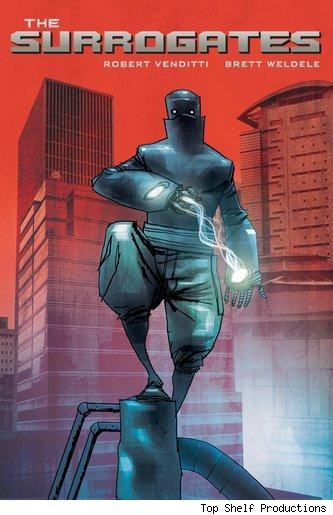I saw the movie “”Surrogates”” this weekend, and I was disappointed. I probably shouldn’t have read the comics before watching the movie.
The plot comes from the comic book miniseries created by writer Robert Venditti and artist Brett Weldele. Like “”Whiteout,”” another recent movie that has been translated from a comic book, “”Surrogates”” features a strong concept that gets diluted by the time it reaches movie audiences.
“”Surrogates”” has many differences from its comic book origins. Characters and plot devices are changed — particularly with the first surrogate attack — and the world is more fully realized in the movie, while the comics remained steadfast in its pursuit of the mystery. Unfortunately, the themes and characterization from the comics are lost in the movie’s wrongheaded focus on the visuals.
Such changes in translation are nothing new. There have been many comics that have been made into movies — “”Men in Black,”” “”Spider-Man,”” “”Ghost World,”” etc. But they often required a director who understands the different demands of each medium and creates a story without losing the essence of the characters.
For example, the Batman franchise has taken its creative cues from the success of Tim Burton’s “”Batman”” and “”Batman Returns,”” that is, to adapt the comics to fit the director’s artistic sensibilities.
With “”Batman and Robin,”” director Joel Schumacher added the vivid campiness from the 1966 TV show, which proved completely at odds with the gothic visual style established by Burton. Its abject failure would mean that no one would take another attempt at a Batman-related movie until 2004, a year which saw “”Catwoman”” somehow avoiding the direct-to-DVD route.
Last year’s “”The Dark Knight”” demonstrated what could happen when the creators grasp the basic nature of the characters and their world. By absorbing and interpreting the best parts of the Batman comics, director Christopher Nolan reminded us that Batman isn’t just about the villains, but how they reflect Bruce Wayne’s noble yet flawed crusade against the corruption rooted in Gotham City. “”The Dark Knight”” raised the issue of how we should confront not only crime but also our personal moral dilemmas.
I doubt the movie would have been as successful if Nolan had lifted a Batman story wholesale from the comics.
Which brings me to Frank Miller and his comics that have been made into movies, “”Sin City”” and “”300.”” Almost every line of dialogue and cinematic screenshot in each movie were taken directly from four of the comic books. This meant that audiences were getting the original comics basically unfiltered, but could they really be called movies?
Robert Rodriguez brought Miller in as co-director of “”Sin City”” to ensure that it mimicked the four stories perfectly. Given Rodriguez’s love of the noir style of the original comics, with their stark black-and-white drawings and pulpy dialogue (he is a good friend of Quentin Tarantino, after all), it made sense why Rodriguez recreated the comics without major changes.
He seemed to regard the comics as paper movies — it’s easy to see why — and probably didn’t see the need to translate them for the big screen. I doubt Rodriguez and Miller were acting in the spirit of Andy Warhol, that is, by declaring “”Sin City”” is a movie rather than an animated comic book because they are directors who made it as a movie.
So what got lost in the transition from comic book to movie? The static images of comics require readers to fill in the gaps between actions. Rodriguez filled in the gaps, but there wasn’t much substance to it.
He adhered to Miller’s stories and visuals too closely, and left behind nothing more than an expensive and elaborate advertisement for the original comics. This probably boosted sales of “”Sin City”” comics, but it doesn’t make for a satisfying movie experience.









